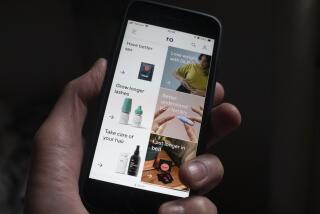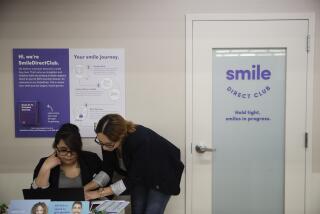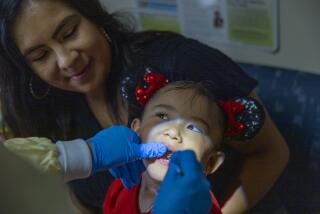Orthodontists aren’t smiling about teeth-straightening start-ups
It’s easier than ever to get straighter teeth. Orthodontists think that’s a big problem.
Where metal braces installed in a doctor’s office were once the only way to correct misaligned teeth, a new method that uses removable clear aligners can eliminate a visit to an orthodontist and save patients thousands of dollars. That’s what led Deniece Hudson, who always dreamed of having straighter teeth, to a start-up called SmileDirectClub.
Hudson, a 24-year-old Georgia Southern University graduate, visited one of the company’s retail outlets in an Atlanta strip mall in February to have her teeth scanned. That experience would turn out to be her only in-person interaction with a medical professional during a nine-month journey through the growing field of tele-orthodontics.
From the scans, SmileDirectClub used 3-D printers to create 24 trays of transparent plastic braces, which were delivered by mail with instructions on when to switch trays. Dentists monitored her progress by looking at selfies she sent over the internet. The only thing she ever learned about the physicians treating her was their last names.
“I trusted the company enough to not actually give me someone who didn’t know what they were doing,” Hudson said.
The program cost $2,170, compared with the $5,000 to $8,000 for a traditional orthodontist using the industry-leading Invisalign system created by Align Technology Inc. With one month to go in her program, Hudson says she’s satisfied with the results.
“I used to be so nervous, but now I’m always smiling,” she said.
Hudson may be grinning, but a growing number of orthodontists aren’t. Instead, they’re warning consumers about the possible dangers of undergoing a complex medical procedure without the in-person supervision of a dental professional. The main orthodonists’ trade association has filed complaints against SmileDirectClub with 36 state dental boards and attorneys general, alleging regulatory and statutory violations.
There’s more to treating a smile than just moving visible portions of the teeth.
— Sean Murphy, American Assn. of Orthodontists associate general counsel
“I don’t think the diagnosis can happen with three clicks,” said Hera Kim-Berman, a clinical assistant professor at the University of Michigan’s department of orthodontics and pediatric dentistry and the program director of orthodontic graduate training. “These companies treat them as consumers, as clients, and that’s really the major difference.”
About 300 million people worldwide with teeth misalignment could benefit from straightening yet are unlikely to seek treatment through a traditional doctor’s office, according to a February securities filing by San Jose-based Align. The global orthodontics market, which includes traditional braces, is projected to increase to $2.6 billion by 2023, from $1.5 billion in 2016, according to Allied Market Research.
SmileDirectClub, which is closely held, is the most prominent of a growing batch of start-ups seeking to capture that market. Since launching in 2014, the company says it has treated more than 250,000 patients with custom-made aligners. It declined to disclose sales figures.
Two key factors are driving growth of the tele-orthodontics business. More sophisticated 3-D printing now enables companies to use digital scanning to create custom-made clear plastic aligners and retainers, which are replacing the metal braces used by orthodontists for decades. And last October, Invisalign lost its exclusivity on 40 patents that kept it as the leading clear-aligner brand, opening the door for newcomers such as SmileDirectClub.
“A lot of our customers at one point had braces, they forgot to wear their retainers, their teeth shifted a little bit,” said SmileDirectClub co-founder Alex Fenkell. “And before SmileDirectClub, they were looking at $5,000 to address something that they’ve already invested in. It just wasn’t making sense to them.”
The American Assn. of Orthodontists, which represents about 19,000 members in the United States and abroad, this year issued a consumer alert warning people of direct-to-patient orthodontic companies like SmileDirectClub, Candid Co. and SmileLove. Consumers should think twice before opting for a procedure “without an in-person, pre-treatment evaluation or ongoing in-person supervision from a medical professional,” the group said.
“There’s more to treating a smile than just moving visible portions of the teeth,” said the group’s associate general counsel Sean Murphy. “If you want to increase access to care, you have to make sure it’s in the best interest of patient health and safety.”
SmileDirectClub says that although its customers never have to visit a doctor’s office, they’re never left alone during the process. The company partners with 225 licensed dentists and orthodontists across all 50 states — each of whom has had at least four years of Invisalign practice — to review customers’ teeth scans or imprints.
“It’s a shame because it’s a typical knee-jerk reaction from an established institution,” Jeffrey Sulitzer, chief clinical officer at SmileDirectClub and a licensed dentist, said in response to the American Assn. of Orthodontists’ reaction. “We’re increasing access to care and driving patients into general dentists offices and orthodontist offices just because we’re increasing awareness of oral care.”
Clear aligners are the largest and fastest-growing category in the global invisible orthodontics market, which includes products made by Align, 3M Co. and ClearCorrect. Within the category, Invisalign captures more than 80% of the market, having served more than 5.8 million patients to date. It makes more than 332,000 unique aligners a day.
Align shares have jumped more than fivefold in the last three years, spurred by a doubling in sales, and the company was among the best performers in the Standard & Poor’s 500 index in 2017. The stock closed at $380.84 on Thursday.
But key patents that protected Invisalign’s design and manufacturing expired in October 2017, and many of Align’s remaining related patents will expire by 2019. The company has been fighting to maintain its market dominance, filing patent lawsuits and trade complaints against smaller rivals, including SmileDirectClub.
A 2015 suit against SmileDirectClub — then known as SmileCareClub — cited infringement on 14 patents related to manufacturing and sales. Align also alleged the company’s “do-it-at-home system” lacked critical oversight and entirely eliminated the doctor’s role in treatment.
Less than a year later, Align dropped the suit as part of a $46.7-million deal that gave it a 17% stake in SmileDirectClub and made it a third-party supplier of a portion of its braces. It has since boosted the stake to 19% with an additional $12.8-million investment.
Meanwhile, in Georgia, Hudson is preparing to finish her treatment with SmileDirectClub on Oct. 10. Although she was aware of some negative reviews left by customers ahead of her teeth-straightening adventure, she’s happy she chose to look past the doubt surrounding tele-orthodontics.
“I know a lot of people are skeptical about SmileDirectClub,” she said, “but it worked for me.”
Wolf writes for Bloomberg.
More to Read
Inside the business of entertainment
The Wide Shot brings you news, analysis and insights on everything from streaming wars to production — and what it all means for the future.
You may occasionally receive promotional content from the Los Angeles Times.









